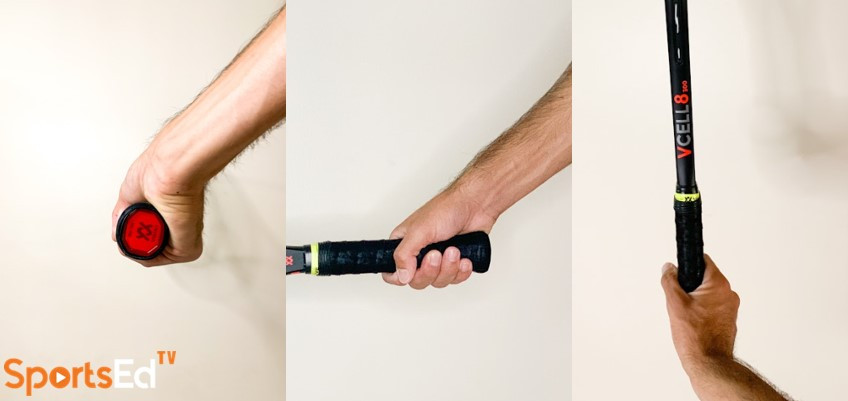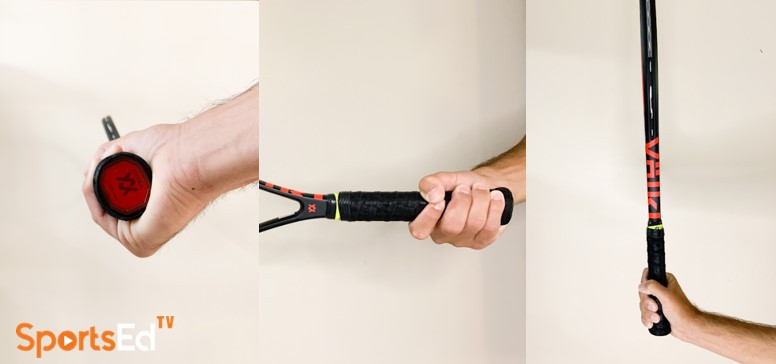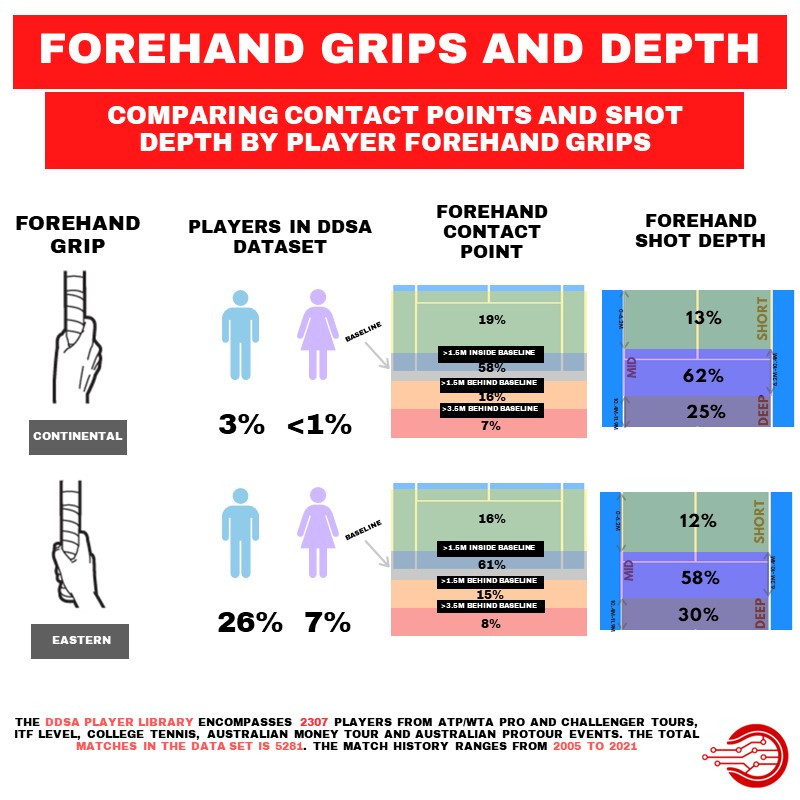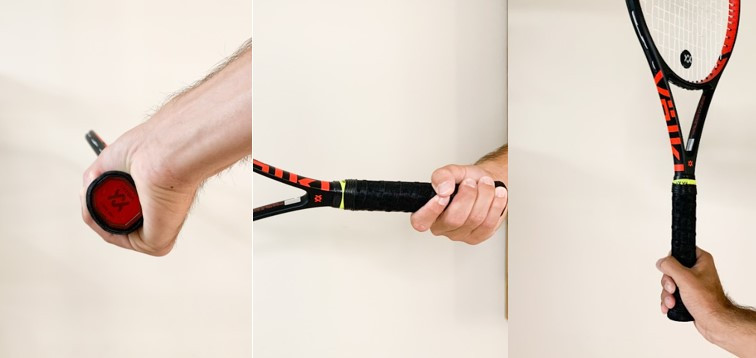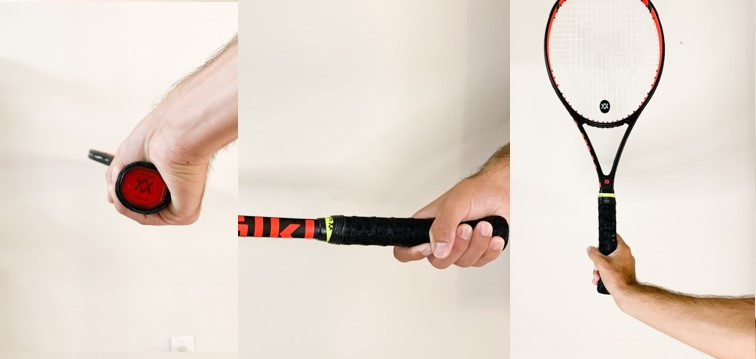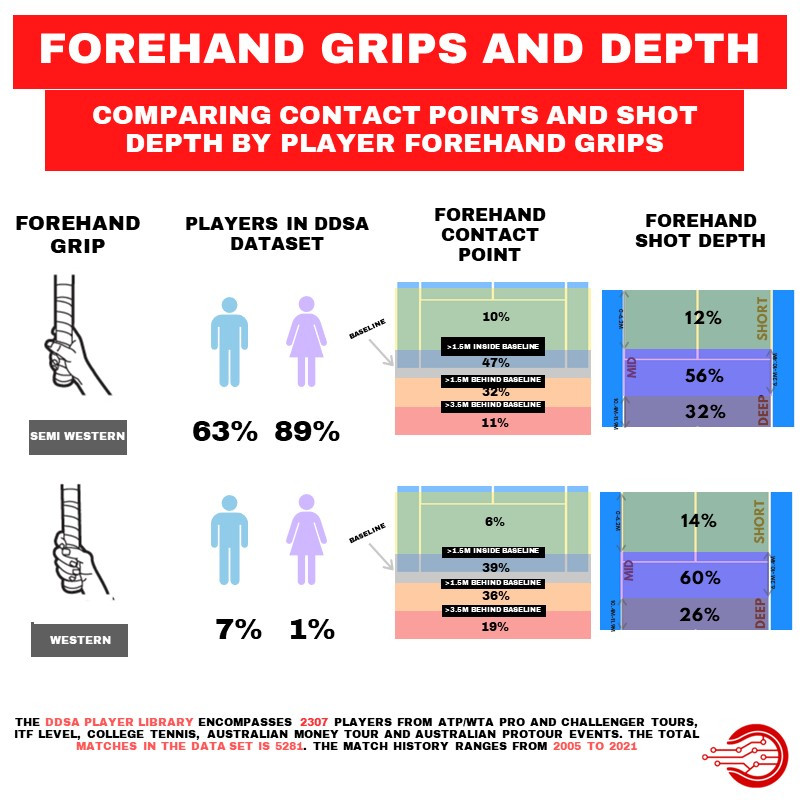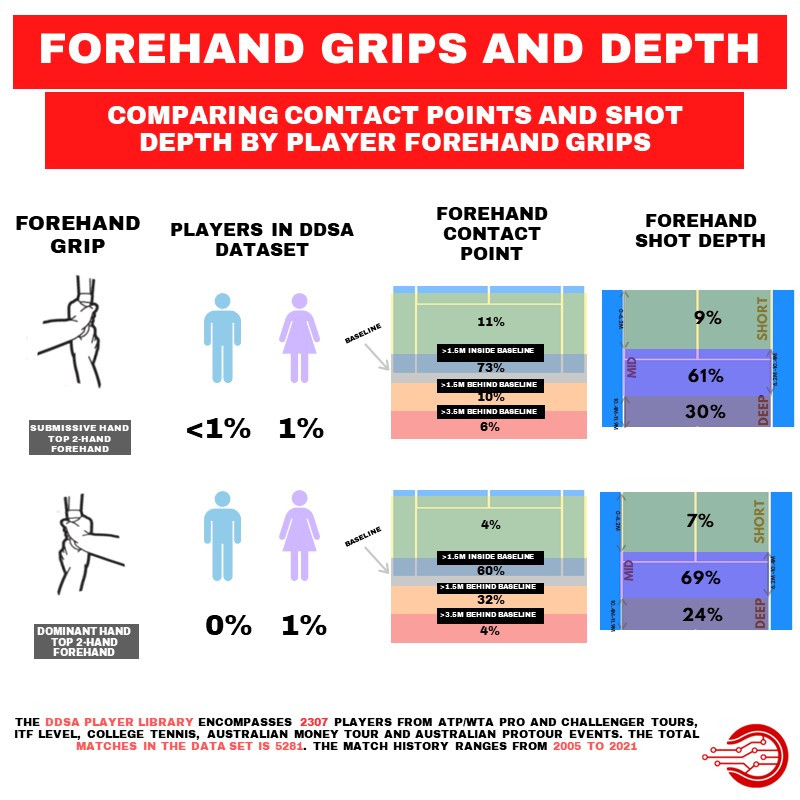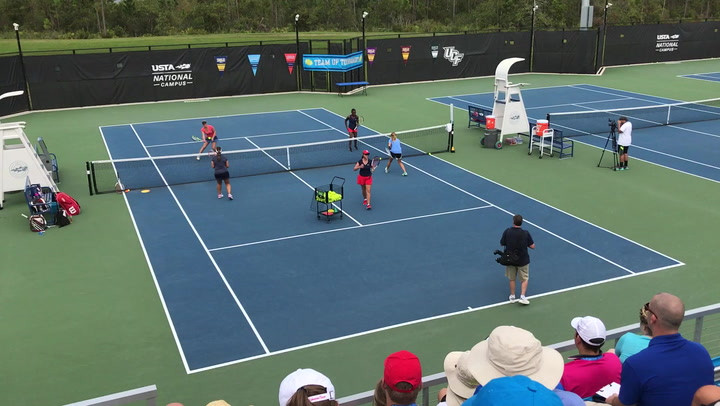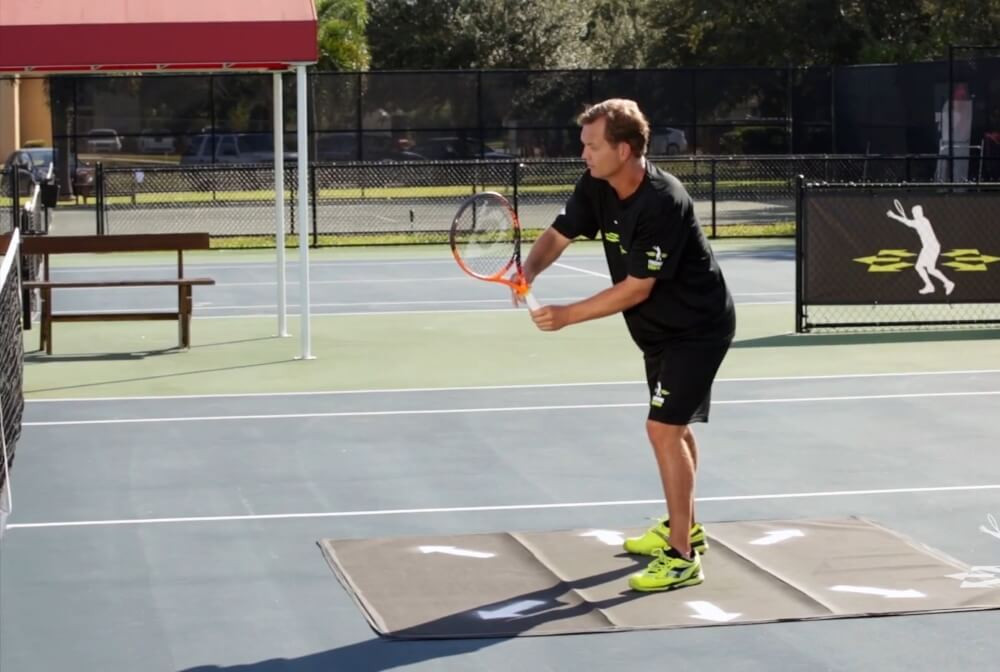Tennis
Welcome and thanks for visiting...

What your forehand tennis grip means for shot depth and point of contact
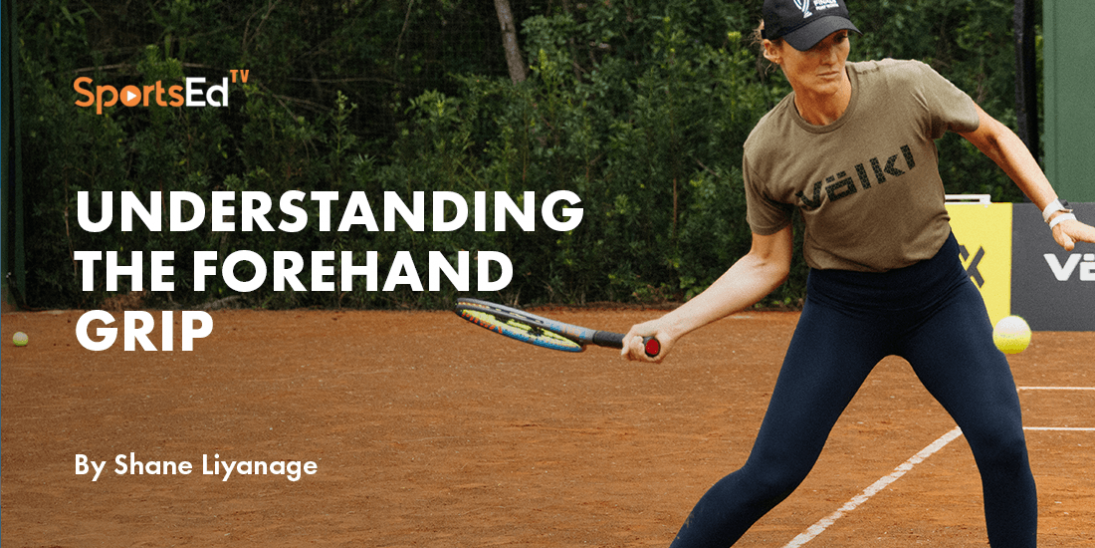
The tennis grip for the forehand is this crucial element of connection between you, your racquet, and the ball. Take a moment to think about how you hold your tennis racquet when you hit a forehand. The feel of your hand palm likely brings a sense of comfort or reflects the way you enjoy playing.
Understanding the Basics of Tennis Grips.
The grip selection that feels natural to you may differ from your tennis partners. For example, you probably hold your tennis racquet by using one of the six following grips: 1) continental, 2) eastern grip forehand, 3) semi-western, 4) western, or if you hit a double-handed forehand, you would use 5) and 6) submissive or dominant hand on top for double-handed forehands grips like Monica Seles and Marion Bartoli.
Forehand Grip
At Data Driven Sports Analytics, we decided to dig into more than 5,000 matches between college-level and WTA/ATP tours to find more about the implication of forehand grip selection on depth shots and point of contact on the court. We share our data analysis in six diagrams, one for each forehand grip.
Let us start with the majority: close to two-thirds of men and almost 9 out of 10 women use the semi-western grip. We found that the utilization of the semi-western grip results in better depth. Balls hit with semi-western forehand grip land closer and inside the baseline relative to players using other grips. For instance, almost one-third of balls land deep with the semi-western grip, as shown in our diagrams. In comparison, players using a continental grip hit one-quarter of their forehand deep.
The eastern forehand grip is the second most popular for both men and women. About a quarter of men use an eastern grip on their forehand, and 7% of women. Those play closer or inside the baseline relative to players using the semi-western grip, hitting less than 1 out of 10 forehands extremely far behind the baseline. Our findings for the contact point on the court are similar for the rare breed using the continental grip like Stefan Edberg and John McEnroe. After all, players using continental or Eastern grips like to use the ball speed of the opponent. Therefore, they have less of a swing making it more advantageous for them to play further up in the court. Also, players using a continental grip hit only one-quarter of forehands deep, less than those using the eastern grip (30%) and semi-western grip (32%).
According to our findings, another finding that strikes out relates to players using a Western grip like Karen Khachanov, as they hit slightly more than half of their balls behind the baseline. Particularly, players with western grip hit close to one forehand out of 5 at least 3.5M behind the baseline. One big reason for this court positioning is the need for more time to swing for players using a Western grip.
What is the Continental grip?
The Continental Grip To establish the continental grip as a right-handed athlete, position the pad of your index finger's lowest knuckle on the second bevel and encircle the handle with your fingers.
To establish the continental grip as a left-handed athlete, position the pad of your index or pointer finger's lowest knuckle on the eighth bevel and encircle the handle with your fingers.
With the continental grip, the tennis racket angle remains neutral, signifying that the racket frame is perpendicular to the ground when held in front of you.
What is the Eastern grip?
The Eastern Grip To create the eastern grip, position the palm side of your index finger's knuckle on the third bevel of the tennis racket if you are right-handed. For left-handed players, place it on the seventh bevel and then securely encircle the handle with your fingers.
A key advantage of the eastern grip is its closeness to the continental grip, which is beneficial as it allows athletes to switch from a forehand to volleys and back swiftly.
This proves particularly useful when a player moves from the baseline to the net after executing an approach shot. Due to the ease of changing grips, the athlete is promptly prepared for the subsequent volley.
What is the Semi-Western grip?
The Semi-Western Grip To create a semi-western grip, situate the index knuckle and heel pad on bevel number 4. An easy method to find this grip is to set the racket face flat on the ground and then lift it.
The foremost advantage of the semi-western grip is a player's capacity to produce significant topspin. With this grip, the angle of the racket face is closed or aimed toward the ground. As a result, when you swing and engage the ball, you can smoothly brush upward and over the tennis ball, generating topspin.
Athletes using a semi-western grip can propel the ball higher over the net while ensuring it descends back into the court, thanks to the created topspin. This strategy allows for more assertive play with an increased margin for error.
The limitations of this grip include the challenge in swiftly transitioning from a forehand to a volley, although consistent practice can help surmount this issue.
Additionally, it can be difficult for players to hit a very low ball, just inches off the ground, as the semi-western grip compels the athlete to hit beneath and over the ball to produce topspin.
What is the Western grip?
To locate the Western grip, position the palm side of your index finger's knuckle on the fifth bevel of the racket handle. The western grip is ideal for a strong baseline game featuring powerful groundstrokes with abundant topspin.
This grip's primary advantage is undeniable, but similar to the semi-western grip, transitioning to a continental grip for slice shots or volleys is not an easy task. It demands significant racket rotation from the player.
Novice players may find the switch challenging – but with dedicated practice, they can gradually grow accustomed to the transition. As with the semi-western grip, striking a low-bouncing ball is difficult using the western grip.
The 2-Handed Forehand
SUBMISSIVE & DOMINANT HAND
Finally, less than 3% of tennis players use a two-hand forehand. Again, the subtlety relates to where you put your dominant and non-dominant hands on the racquet, ultimately impacting more where you positioned yourself when hitting on the court than the depth of the shot.
In summary, the old saying is simple: tell me how you hold your racquet, and I will tell you what kind of tennis player you are. We invite you to think about your forehand grip next time you go on the tennis court. Feel free to experience variations, for better or, the worse. You may end up with various positioning, inside or behind the baseline, and hit different spots when your ball lands on the other side of the court. At the other end of the spectrum, talking to your friendly partner about his/her grip may give you clues about his/her game and what to expect from him when he/she hits forehands.


